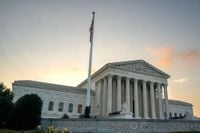The nation’s largest anti-hunger program has become the latest flashpoint in a high-stakes legal and political battle, as the Trump administration and a coalition of states, cities, and nonprofits square off before the Supreme Court over the fate of federal food stamp funding. The dispute, which has unfolded against the backdrop of a record-long government shutdown, centers on whether the federal government must continue to fully fund the Supplemental Nutrition Assistance Program (SNAP) for November—despite a lapse in appropriations and escalating partisan tensions in Washington.
On Monday, November 10, 2025, the Trump administration returned to the Supreme Court in an urgent bid to halt a lower court order that would require the government to finance full SNAP benefits for the roughly 42 million low-income Americans who depend on the program. This move came even as Congress inched toward a deal that could end the shutdown and restore funding for critical nutrition programs, according to The New York Times and SCOTUSblog.
At the heart of the legal fight is a series of rulings from U.S. District Judge John J. McConnell, Jr. in Rhode Island. On November 1, Judge McConnell directed the government to fully fund SNAP benefits for November by November 3, or at least partially fund them by November 5, using emergency reserves. When the Trump administration failed to act swiftly, McConnell issued a follow-up order on November 6, demanding that full funding be provided by November 7. The administration, however, balked at these demands, setting off a flurry of appeals and emergency motions.
Solicitor General D. John Sauer, representing the Trump administration, sharply criticized the district court’s intervention. In a brief filed Monday afternoon, Sauer argued that Judge McConnell’s order “inject[s] the federal courts into the political branches’ closing efforts to end this shutdown.” He insisted, “The only way to end this crisis—which the Executive is adamant to end—is for Congress to reopen the government.” Sauer further described the court’s instructions as “massively inappropriate,” claiming that conflicting orders had sown “upheaval” and disrupted the work to end the shutdown. He warned that allowing district courts to decide how to allocate limited funds could create “grave” irreparable harm and “sow further shutdown chaos.”
Yet, as SCOTUSblog reported, the challengers—comprising nonprofits, cities, and nearly two dozen states—countered that the real chaos stemmed from the Department of Agriculture’s “delays and intransigence, not by the district court’s efforts to mitigate that chaos and the harm it has inflicted on families who need food.” They argued that even with ongoing negotiations to end the shutdown, “that is a reason to deny a stay” of McConnell’s ruling, “not to grant it.”
The legal saga has been marked by rapid-fire developments. After the Trump administration’s initial request for an administrative stay was denied by the U.S. Court of Appeals for the First Circuit on Friday, November 7, Justice Ketanji Brown Jackson stepped in late that night, issuing a temporary pause to give the appeals court time to review the matter. But by Sunday night, November 9, the First Circuit rejected the administration’s plea for a stay, leaving Judge McConnell’s order in place. This prompted Justice Jackson to instruct the administration to quickly inform the Supreme Court whether it would continue seeking a stay and to file any supplemental briefs by Monday afternoon.
Meanwhile, the administration’s legal maneuvers have drawn fierce criticism from state officials and advocates. Letitia James, the Democratic attorney general of New York, vowed to use “every legal pathway to ensure families get the benefits they are entitled to.” She declared, “It is a moral imperative, and no one should go hungry because their own government is refusing to feed them.” Matthew J. Platkin, New Jersey’s attorney general, went even further, calling the federal government’s attempts to slash food stamps “the most heinous thing” he had seen in office.
Nonprofit leaders echoed these sentiments. Diane Yentel, president of the National Council of Nonprofits, condemned what she described as “the administration’s callous and cruel use of hungry Americans as a political tool.” According to The New York Times, the coalition of local governments, religious groups, and nonprofits has been working tirelessly to shield vulnerable Americans from financial hardship as the shutdown drags on.
The administration’s arguments have not gone unchallenged on technical grounds, either. The challengers disputed the government’s claim that using the Child Nutrition account to make up the SNAP shortfall would create a “significant shortfall” for children who rely on school lunches. They pointed out that nearly $20 billion remained in the account—enough, they insisted, to fully fund Child Nutrition programs through May 2026, even if the shutdown continued. “It is critically important to provide support for child nutrition,” the challengers acknowledged, but maintained that the administration’s warnings about funding gaps were unfounded. They urged the Supreme Court to “deny the government’s application and not allow any further delay in getting vital food assistance to people who need it now.”
The First Circuit’s 29-page opinion, handed down late Sunday, was scathing in its assessment of the administration’s tactics. “For low-income Americans, SNAP is a vital bulwark against hunger and food insecurity,” the appellate court wrote. “Access to food is, of course, a basic human need.” The judges faulted the administration for “proceed[ing] to do nothing to attempt to solve that problem” in ways that would have preserved the food stamp program and spared it from significant delays. The opinion also noted that the government “knew full well” that making only partial payments would be “technically difficult.”
Despite the bitter legal wrangling, there are signs that the impasse could soon be resolved through political means. In his Monday brief, Solicitor General Sauer acknowledged that the Senate had “begun the process for ending the shutdown and funding the government—including full funding for SNAP through the end of the fiscal year—though the outcome of that process remains, to be sure, uncertain.” The administration itself admitted that a congressional deal could render its Supreme Court application moot, but pressed ahead with its legal challenge nonetheless, arguing that the district court’s order was “indefensible on the merits” and disruptive to ongoing negotiations.
As the Supreme Court weighs its next move, millions of Americans remain in limbo, unsure if and when their food assistance will arrive. The outcome of this case will not only determine the immediate fate of SNAP payments during the shutdown, but could also set a precedent for how the courts and the executive branch handle future funding crises. With the stakes so high, and the rhetoric on both sides growing ever sharper, all eyes are on Washington to see whether the nation’s most vulnerable families will get the help they need—or be left waiting once again.
For now, the legal and political drama continues, with the Supreme Court poised to play a decisive role in the outcome. The coming days will reveal whether the courts, Congress, or the administration will ultimately shape the future of America’s food safety net.




